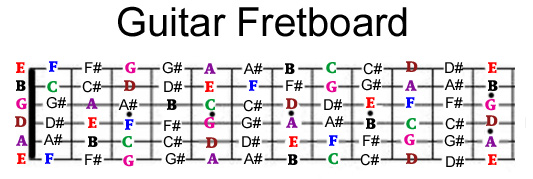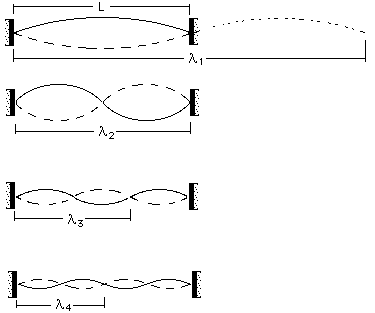 |
| Similarly, the sounds produce by an acoustic guitar follows the same principles of the link between amplitude and volume, and the link between frequency and pitch. |
 |
| This is the nylon string guitar having a softer touch effect and generally a softer sound. |
 |
| These are the metal strings guitar that are generally louder because of the more vibrations it can produce. |
 |
| This graph shows the sounds produce by the guitar in terms of time. It is very clear that the guitar does not give out perfect pitch sounds like an oscilloscope and this is the reason for its unique tones. |
Generally the pitch of the guitar depend of certain things.
1) The mass of strings
2) The tension of the strings
3) Free space of the strings
4) The vibration of the strings
The final thing I would like to write about is the sound linkage and frequency.
 |
| Theses are all the notes of 1 octave in a guitar fret board. Each fret that a player presses on, produces a frequency that results in all these different pitches. |
Generally, the sound of a guitar follows the physics formula of Frequency=Speed/Wavelength.
That is why when a guitarist moves up the fret board, the pitch gets higher because the shorter the wavelength, the higher its frequency. The thicker the string, the slower it moves,explaining why the thicker ones produce a smaller frequency,giving a smaller frequency.
 |
| The 2 ends show the whole wavelength of guitar. |
As we follow a certain formula, we can calculate what pitch the guitar would give when we press of a fraction of the whole fret board.
| scale position touched | fraction of string length | ||
| octave | 1/2 | ||
| fifth | 1/3 | ||
| fourth | 1/4 | ||
| major third | 1/5 | ||
| minor third | 1/6 | ||
| augmented fourth | 2/7 | ||
| minor sixth | 3/8 | ||
| major second | 1/9 |
To conclude, there is more to a guitar then I have just mention. There are more complicated formulas and information which goes into a very high level of physics. These blogs has indeed help me to understand that there is a science behind the instrument I play.
Thank You
Elijah Wong
Sources:
http://newt.phys.unsw.edu.au/~jw/guitarintro.html
http://newt.phys.unsw.edu.au/jw/strings.html
http://ideastations.org/science-matters/sites-and-wonders/guitars-sounds-and-science
http://www.businessinsider.my/physics-guitar-mystery-oxford-rockstar-rock-music-2014-9/#JMCgmKZtilT2lxdJ.97
http://www.premierguitar.com/articles/The_Science_of_Tone
http://www.soundonsound.com/sos/may02/articles/cholakis.asp
https://www.google.com/search?q=guitar+fretboard&espv=2&biw=1366&bih=623&source=lnms&tbm=isch&sa=X&ved=0CAYQ_AUoAWoVChMIvNGEvbyKxwIVSFCOCh1xJgwY#imgrc=6UoVO0hJrvsbwM%3A
No comments:
Post a Comment